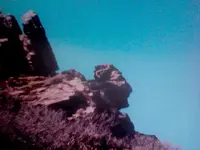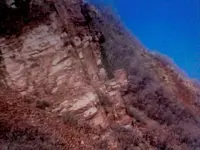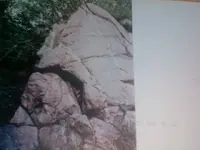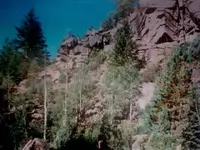Mayan Hunter
Jr. Member
- Joined
- Jan 25, 2011
- Messages
- 34
- Reaction score
- 12
- Golden Thread
- 0
- Location
- Utah desert
- Detector(s) used
- Bounty Hunter/Colt 44/Fisher Gemini lll/Minolta 400 SLR
- Primary Interest:
- Cache Hunting
- #1
Thread Owner
First off, in comparing notes with a fellow treasure hunter of spanish caches, We're both convinced that the Jesuits were heavy into mining. They were the ones to mark the trails with signs in the rocks leading to the main entrance of the mine. They also marked the signs opposite of what the King ordered. What that means is the BIG signs were at the end of the trail. And in 100% of the cases the head or face is pointed or looking to where the entrance is.
Recently I found a head looking across a canyon and spotted a white eye catcher. It was pointed like an arrow head pointing to the left. Following to the left about 200 feet away were 3 square stones next to each other. This is the sign of the Jesuits. It represents Father, Son, HolyGhost.
Hiking up to the 3 square stones, it turned out to be one large stone that had been notched to appear like three. From those 3 about 40 feet west we found a large stone turtle with its head pointing straight up, front feet perfectly shaped and the body appeared to be buried. Directly east we found another turtle with its head down and pointing down and in towards the other turtle. Evidently its not the tail that points to the treasure, its the head. And all these years I've been mislead about that. Completing the triangle was a large white eye catcher rock. And in that area, as soon as the snow melts we should find the cache.
All the trails were marked in the mountain tops with a "U" shape, or a "W" taking out the middle hump. After you see that you just drive or hike up toward the U shape, keeping an eye peeled for lighter stones, eye catchers. Look all around the eye catcher for the next sign, and don't forget your camera. Take lots of pictures. The spanish always put a small 'x' near their signs to show its spanish and not mother nature. And there was supposed to be 2 trails cut. Look for "hearts" in stone (GOLD) symbol. Actually they only marked Gold mines, the king was only interested in gold. When you see the head, thats the big sign, you're almost there. Even if you have to climb up next to the head to see what its looking at, do it.
In the area I'm in the spanish were here in 1575 until 1810. They all left hurriedly in 1810 to fight the mexicans in a long war that they eventually lost. They cached all they had mined near the entrance of the mine and covered them up. Also in about 1700, there was a BIG earthquake, that caved many mines and many miners were lost. So the King ordered that a parallel tunnel be dug 15 to 20 feet away as a rescue tunnel. They never covered this one. So if you see one not covered, open, that's the rescue tunnel, I call it the 'Dummy Mine'. You'd be a dummy to explore it because there is nothing in it. It's fooled many. However if you find one get out your 2 box and check all around the entrance for the REAL mine's cached entrance.
Buy a copy of Kenworthy's Trail Monument Markers. It will teach you what to look for as far a faces and other markers, like a compass rock. And if you see 3 stones under the compass rock, its Jesuit. Eventually the king arrested the Jesuits and deported them around 1760, but the damage had been done. By the way, the Jesuits never paid the king his 20% tax.
Recently I found a head looking across a canyon and spotted a white eye catcher. It was pointed like an arrow head pointing to the left. Following to the left about 200 feet away were 3 square stones next to each other. This is the sign of the Jesuits. It represents Father, Son, HolyGhost.
Hiking up to the 3 square stones, it turned out to be one large stone that had been notched to appear like three. From those 3 about 40 feet west we found a large stone turtle with its head pointing straight up, front feet perfectly shaped and the body appeared to be buried. Directly east we found another turtle with its head down and pointing down and in towards the other turtle. Evidently its not the tail that points to the treasure, its the head. And all these years I've been mislead about that. Completing the triangle was a large white eye catcher rock. And in that area, as soon as the snow melts we should find the cache.
All the trails were marked in the mountain tops with a "U" shape, or a "W" taking out the middle hump. After you see that you just drive or hike up toward the U shape, keeping an eye peeled for lighter stones, eye catchers. Look all around the eye catcher for the next sign, and don't forget your camera. Take lots of pictures. The spanish always put a small 'x' near their signs to show its spanish and not mother nature. And there was supposed to be 2 trails cut. Look for "hearts" in stone (GOLD) symbol. Actually they only marked Gold mines, the king was only interested in gold. When you see the head, thats the big sign, you're almost there. Even if you have to climb up next to the head to see what its looking at, do it.

In the area I'm in the spanish were here in 1575 until 1810. They all left hurriedly in 1810 to fight the mexicans in a long war that they eventually lost. They cached all they had mined near the entrance of the mine and covered them up. Also in about 1700, there was a BIG earthquake, that caved many mines and many miners were lost. So the King ordered that a parallel tunnel be dug 15 to 20 feet away as a rescue tunnel. They never covered this one. So if you see one not covered, open, that's the rescue tunnel, I call it the 'Dummy Mine'. You'd be a dummy to explore it because there is nothing in it. It's fooled many. However if you find one get out your 2 box and check all around the entrance for the REAL mine's cached entrance.
Buy a copy of Kenworthy's Trail Monument Markers. It will teach you what to look for as far a faces and other markers, like a compass rock. And if you see 3 stones under the compass rock, its Jesuit. Eventually the king arrested the Jesuits and deported them around 1760, but the damage had been done. By the way, the Jesuits never paid the king his 20% tax.










